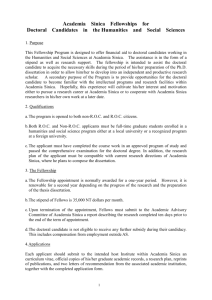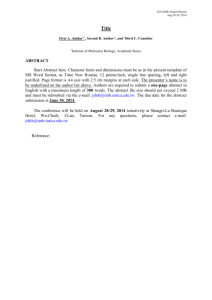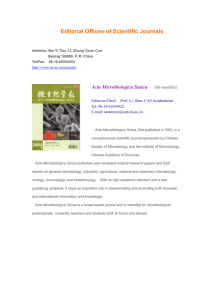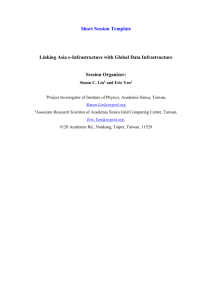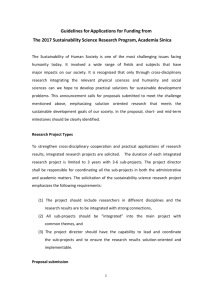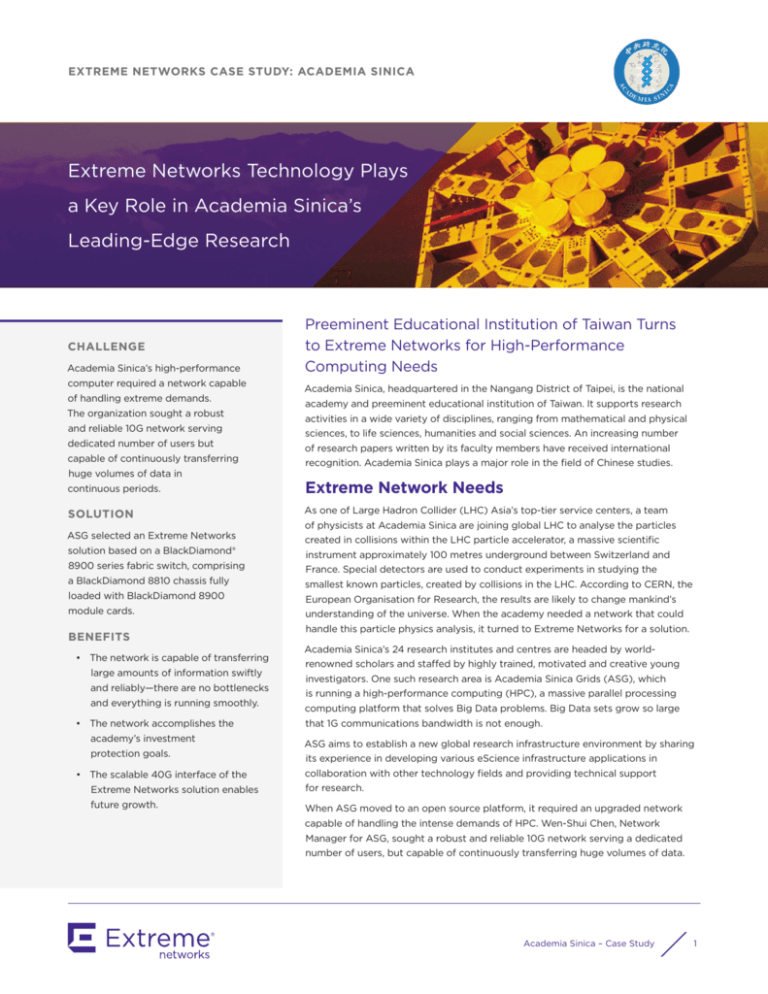
EXTREME NETWORKS CASE STUDY: ACADEMIA SINICA
Extreme Networks Technology Plays
a Key Role in Academia Sinica’s
Leading-Edge Research
CHALLENGE
Academia Sinica’s high-performance
computer required a network capable
of handling extreme demands.
The organization sought a robust
and reliable 10G network serving
dedicated number of users but
capable of continuously transferring
huge volumes of data in
Preeminent Educational Institution of Taiwan Turns
to Extreme Networks for High-Performance
Computing Needs
Academia Sinica, headquartered in the Nangang District of Taipei, is the national
academy and preeminent educational institution of Taiwan. It supports research
activities in a wide variety of disciplines, ranging from mathematical and physical
sciences, to life sciences, humanities and social sciences. An increasing number
of research papers written by its faculty members have received international
recognition. Academia Sinica plays a major role in the field of Chinese studies.
continuous periods.
Extreme Network Needs
SOLUTION
As one of Large Hadron Collider (LHC) Asia’s top-tier service centers, a team
ASG selected an Extreme Networks
created in collisions within the LHC particle accelerator, a massive scientific
solution based on a BlackDiamond®
8900 series fabric switch, comprising
a BlackDiamond 8810 chassis fully
loaded with BlackDiamond 8900
module cards.
BENEFITS
• The network is capable of transferring
large amounts of information swiftly
and reliably—there are no bottlenecks
and everything is running smoothly.
• The network accomplishes the
academy’s investment
protection goals.
• The scalable 40G interface of the
Extreme Networks solution enables
future growth.
of physicists at Academia Sinica are joining global LHC to analyse the particles
instrument approximately 100 metres underground between Switzerland and
France. Special detectors are used to conduct experiments in studying the
smallest known particles, created by collisions in the LHC. According to CERN, the
European Organisation for Research, the results are likely to change mankind’s
understanding of the universe. When the academy needed a network that could
handle this particle physics analysis, it turned to Extreme Networks for a solution.
Academia Sinica’s 24 research institutes and centres are headed by worldrenowned scholars and staffed by highly trained, motivated and creative young
investigators. One such research area is Academia Sinica Grids (ASG), which
is running a high-performance computing (HPC), a massive parallel processing
computing platform that solves Big Data problems. Big Data sets grow so large
that 1G communications bandwidth is not enough.
ASG aims to establish a new global research infrastructure environment by sharing
its experience in developing various eScience infrastructure applications in
collaboration with other technology fields and providing technical support
for research.
When ASG moved to an open source platform, it required an upgraded network
capable of handling the intense demands of HPC. Wen-Shui Chen, Network
Manager for ASG, sought a robust and reliable 10G network serving a dedicated
number of users, but capable of continuously transferring huge volumes of data.
Academia Sinica – Case Study
1
“We are benefiting from the easy
integration and high levels of
reliability of Extreme Networks
technology. There are no bottlenecks,
and everything is running smoothly.”
WEN-SHUI CHEN,
NETWORK MANAGER,
ACADEMIA SINICA
“Customers have great confidence
in Extreme Networks based on its
advanced technology.”
WEN-SHUI CHEN,
NETWORK MANAGER,
ACADEMIA SINICA
Ultimately, the 10G throughput will be accelerated to 100G. Excellent priceperformance was a top priority. At present the Infrastructure as a Service (IaaS)
solution is still in its testing phase, with throughput varying between 10G and 20G
over continuous periods. Testing is progressing well.
To support the Large Hadron Collider (LHC) as part of a worldwide LHC Computing
Grid (WLCG) project, as well as other research initiatives, ASG implemented over
2500 blade servers in its computer facility. With more than 5.4petabytes current
storage capacity and 9.5petabytes planned in the future, it represents Taiwan’s
biggest data center.
According to Wen-Shui Chen, “We were already using Extreme Networks
technology, but when we evaluated vendors’ switching gear capable of expanding
the network to accommodate HPC architecture, we sought great priceperformance backed by fast delivery. Extreme Networks offering ticked all the
boxes, plus we had experienced excellent service from them in the past.”
The Right Solution
ASG selected an Extreme Networks BlackDiamond 8900 series fabric switch,
comprising a BlackDiamond 8810 chassis fully loaded with BlackDiamond 8900
module cards. There are six port splitters, each converted 40G to 4-port 10G,
giving 24 x 10G per slot x 8 cards/system – for a total of 192 ports running at 10G
in the single chassis. The organisation is Extreme Networks biggest blade server
customer in Taiwan, with 52 racks in 135m^2.
The BlackDiamond 8900 is managed by pre-existing Ridgeline™ software from
Extreme Networks. Ridgeline is a scalable, full-featured network and service
management tool that simplifies configuration, provisioning, troubleshooting and
status monitoring of IP-based networks.
The Extreme Networks technology has fulfilled Academia Sinica’s HPC network
needs for a flexible and economic solution capable of transferring large amounts
of information swiftly and reliably. “The BlackDiamond is a great fit for large and
dense networks,” said Chen. “The scalable 40G interface enables future growth
and customers have great confidence in Extreme Networks based on its advanced
technology. We have been working with them for years and experienced the good
performance, high levels of reliability, and comprehensive service.”plans. We made
the right choice with Extreme Networks.”
Upwards to 40G
According to Chen, the strength of the Extreme Networks approach is embodied
in the scalability of its 40G interface. “The 10G port price is comparably lower
than normal pricing. Extreme Networks new 40G blade can be split into 4 ports
with 10G performance yet still has a future 40G expansion capability,” he said. “It
accomplishes both our price-performance requirements and our investment
protection goals.”
He adds, “Already, we are benefiting from the easy integration and high levels
of reliability of Extreme Networks technology. There are no bottlenecks, and
everything is running smoothly. Equally importantly, Extreme Networks architecture
enabled us to simplify the network by cutting out the aggregation layer.”
Future plans for the HPC network include upgrading to 40G, if file server
implementation is required. Ultimately, Chen envisions a cloud service with 1,000plus virtual machine (VM) nodes.
http://www.ExtremeNetworks.com/contact
Phone +1 408 579 2800
©2014 Extreme Networks, Inc. All rights reserved. Extreme Networks and the Extreme Networks logo are trademarks or registered trademarks of Extreme Networks,
Inc. in the United States and/or other countries. All other names and trademarks are the property and trademarks of their respective owners. For additional information
on Extreme Networks Trademarks please see http://www.extremenetworks.com/about-extreme/trademarks.aspx. Specifications and product availability are subject to
change without notice. 1841-0612
WWW.EXTREMENETWORKS.COM
Academia Sinica – Case Study
2

